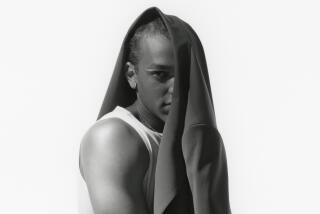FASHION : Beefing Up Athletes’ Suit Sizes
- Share via
The business suit is going beefy. That’s right, all those pumped-up guys who have been deflated at the prospect of buying a traditional suit will find it easier to get a good fit right off the rack.
As anyone who has ever used Nautilus knows, most men’s suits are made with a 6- or 7-inch “drop” between the chest and waist sizes. A Size 42 suit, for example, usually includes pants with a 36-inch waist.
Even for the mildly muscular, that’s not much of a spread. To complicate matters, it is difficult to take in pants more than a couple of inches without having to completely re-tailor them.
This sizing has forced some men to pair slacks in one size with sport jackets in another, even for dress. Or to buy custom-tailored suits, which usually cost at least $600.
Now, more companies are tuning into the muscular customer and testing 8-inch, even 10-inch, drops in hopes of filling their needs. “It’s rejuvenating the suit business,” says Thomas Julian, assistant fashion director for the New York-based Men’s Fashion Assn.
Julian says companies that produce such lines include Henry Grethel and Pierre Cardin. The cut accounts for 30% of Cardin’s suit business, Julian says. The Broadway stocks 8-inch-drop suits in 15 stores, he adds.
Although others are just starting out in the business, two companies have been making “big” suits for years: Haggar, clothier of Everyman, and the 500 Fashion Group, probably best known for its Botany 500 line.
“This whole evolution (in athletic-fit suits) is almost a survival tool for the tailored-clothing business,” says Jim Lewis, vice president of merchandising for Haggar, which makes the Gallery line of athletic-fit clothing.
The line, aimed at men ages 18 to 45, started with casual clothes and grew into the sport coat and suit business. Lewis estimates that 30% of men are potential customers.
To attract fashion-conscious, physically fit men, Lewis says, “we go into the higher-priced markets and get direction and inspiration from designers such as Armani and Hugo Boss.”
Gladiator, part of 500 Fashion Group, has been making athletic-fit suits since 1975. “The whole concept really started in the upper half of the United States, from Chicago to Seattle,” says President Mitchel Nichnowitz. “We saw a need 15 years ago. People there are built a littler bigger.”
The suit jackets are cut fuller in the chest, shoulders and arms but slimmer at the waist. The pants have fuller seats and thighs, smaller waists and a lower rise. In other words, they show off the fact that the wearer has been pumping iron.
“Guys like it to be known that they’re athletic,” Nichnowitz says. “It’s sort of a macho thing.”






